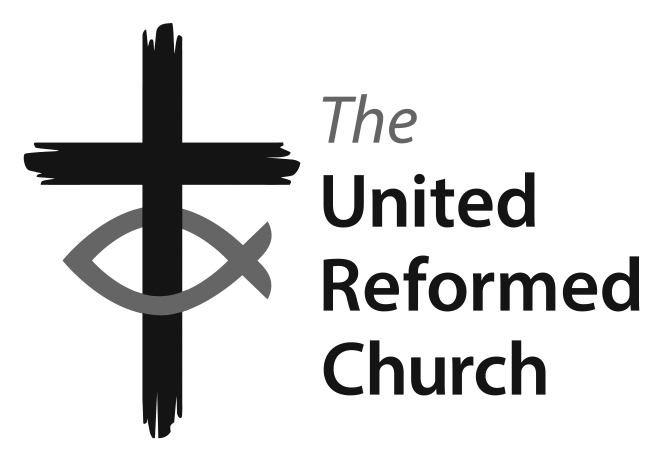Sorry this item is currently out of stock - please call the publication department on 020 7916 2020 for further information.
Share this article
General
Logo – URC
The URC logo available for download from this page is the official logo of the United Reformed Church. We encourage its use by all United Reformed churches, local ecumenical partnerships involving the URC and any partner or associated organisations – all are permitted to use this logo on their online and print material, noting that it must be used in line with the guidelines as detailed in these Guidelines for the use of the URC logo which we recommend you read.
View and download the URC 50th Anniversary logo here.

The URC logo is currently available for download in the following colour ways:
- blue fish with black cross
- greyscale fish with black cross
- White throughout
- All the above but with attached URL: www.urc.org.uk (please use this version wherever possible).
a) greyscale fish with black cross

 b) blue fish with black cross
b) blue fish with black cross
Formats available
PNG version – specifically used for web/screen/email, smallest file size – low quality.
With URL:
Without URL:
- URC-LOGO-greyscale (medium)
- URC-LOGO-greyscale (small)
- URC-LOGO-blue (medium)
- URC-LOGO-blue (small)
- URC-LOGO-White (large)
- URC-LOGO-White (medium)
- URC-LOGO-White (small)
- Favicon with white backing (64 x 64)
- Favicon no backing (64 x 64)
- URC-LOGO-Device-greyscale (medium)
- URC-LOGO-Device-greyscale (small)
- URC-LOGO-Device-blue (medium)
- URC-LOGO-Device-blue (small)
- URC-LOGO-Device-White (medium)
JPG print version – mainly for print - CMYK (but also if required as a larger size for screen/web – for higher quality use RGB version)
With URL:
Without URL:
Illustrator CS6 (ai) vector version – this version can be used by most designers, printers and sign makers.
Often preferred if the logo needs to be enlarged for posters and banners (EPS versions and high resolution large JPGs, for outdoor signage, will be produced after General Assembly). Please contact graphics@urc.org.uk if the version you require is not in the list below.
- CMYK-URC-LOGO-greyscale (A4)
- CMYK-URC-LOGO-blue (A4)
- Solid-black-URC-LOGO (A4) used by craft workers and printers (for example screen printing single colour ink onto pens or etching onto glass). If your printing company can only use a single colour then use this version and request your printer to print to the nearest values below.
URC blue for Print CMYK: 100-0-0-0
URC blue for screen RGB: 0-153-255
URC blue for WEB: #0099FF - Solid-white-URC-LOGO (A4)
Guidelines for use
We are keen for logo to be used as widely as possible to promote the URC and the URC community. However, derivative versions of the URC logo are generally prohibited, as they dilute the URC’s brand identity. For example the URC logo should be used in its entirety and not broken into elements – the words and the cross & fish symbol may not be used separately. If you have any questions, please contact us by email at graphics@urc.org.uk. For more information on how and when it may be used please refer to the Guidelines for the use of the URC logo.
The URC logo is copyrighted to the United Reformed Church © 2016. The URC takes seriously its responsibility for defending our logo against any damaging or confusing uses.

New!
In addition to the above logos we have developed the version below for church use. Available in a variety of formats:
1) the URC cross as a jpg 4:3 with images and a jpg 16:9 with images already added, formatted so that you may add this to a PowerPoint presentationIn addition to the above logos we have developed the version below for church use. Available in a variety of formats:
2) as a jpg with images already added, for use for example on a poster
3) also available upon request from graphics@urc.org.uk is a Photoshop PSD template. You may add your own images in the background to this file (note you will need Adobe Photoshop software to add the images or you may take this to a local printer/designer to do this for you).
The following logos have been requested by local URCs and we share them here in case you would like to use them too.

Rainbow logo


Probation
What is a probationary period?
The main purpose of an employee’s probationary period is to ensure an individual’s capability, reliability and suitability for permanent employment. A probationary period is usually 6 months, but it can be shorter or longer, depending on the role and/or terms of the contract.
If the individual’s performance, attendance and conduct have been satisfactory then the individual should successfully complete their probationary period. As long as the sickness absence record is also satisfactory then the individual should be informed in writing as soon as possible after the end of their probationary period.
If however the individual does not meet the required performance, attendance or conduct standards, an extension to the probationary period may be appropriate.
Extension of Probation
An extension of the probationary period should only be given if there are definitive indications, and not just hope, that the individual will achieve the standard required, given further time to improve. Such an extension (which should be exceptional) would usually be for 3 months.
If there is no hope of the individual’s improvement, the appointment must be terminated at the end of the probationary period. A decision to terminate the appointment can be made at any time during the probationary period, if the individual falls below the required standard and sufficient improvement is not expected. However, correct capability or disciplinary procedures must be followed.
Holidays
How much holiday should I give my staff?
Full-time employees are currently entitled to 28 days paid annual holiday by law. You may give more than the statutory 28 days, but no less, as long as it written into their contract.
If an employee works less than full-time, the entitlement should be pro rata. It is advisable to calculate part time holiday entitlement in hours rather than days.
Both the employee and the employer should give notice as to when holiday should, or should not, be taken. As an employer you can specify periods that your staff have off – for example a shutdown over Christmas and New Year.
If an employee leaves they have the right to be paid for any accrued holiday that has not been taken.
Are bank holidays included in holiday entitlement?
You do not have to give your employees bank holidays off as paid leave and have the option to include bank holidays as part of the 28 days leave. If you choose to offer bank holidays in addition to the statutory minimum, this should be stated in the contract of employment.
Dismissal
What are fair reasons for dismissal?
The below are potential fair reasons for the dismissal of an employee which include:
1. Misconduct
Dismissal due to misconduct usually means that the employee behaved in an unacceptable way. This may be because of a series of less serious incidents of misconduct. e.g.
- continually missing work;
- refusing to obey instructions; or
- single incident of gross misconduct.
It is vital that you follow a fair disciplinary procedure before dismissing your employee for misconduct/gross-misconduct
2. Capability
Capability refers to two areas:
Poor Performance
This is where the employee is not meeting the standards of the post they are employed to do. This may be due to the employee lacking the necessary skills and aptitude required for the post. The employer will need to determine whether the problem is a result of the employee being unable to do their job (capability) or choosing not to do their job (misconduct – see above). You should make sure you give your employee adequate training to do their job.
If the employee is not performing to the required standard, you should make sure that you follow a capability procedure. The employee should be warned that their work isn't satisfactory and be given a chance to improve before any action is taken.
Health-related Poor Performance
Health related matters might also impact on an employee’s ability to perform their role. It is expected that in such circumstances the employer will respond sensitively. This may include seeking permission to obtain a medical report for deciding what further action should be taken.
3. Redundancy
Redundancy is a type of dismissal. Redundancies take place for a number of reasons including a lack of work for a particular role, insufficient funding or changes in organisational requirements which may affect staffing needs.
It is important to ensure that the reason for redundancy is fair and also that a sufficient consultation process takes place with your employee(s).
4. Continual employment would be against the law
e.g. where a work permit has expired.




